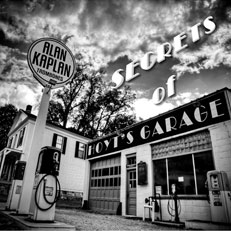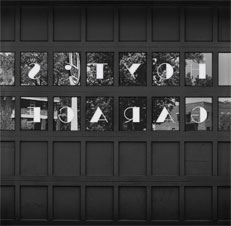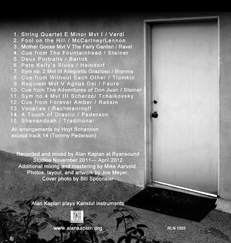
Secrets of Hoyt's Garage
Read about Alan's new hit CD Secrets of Hoyt's Garage..
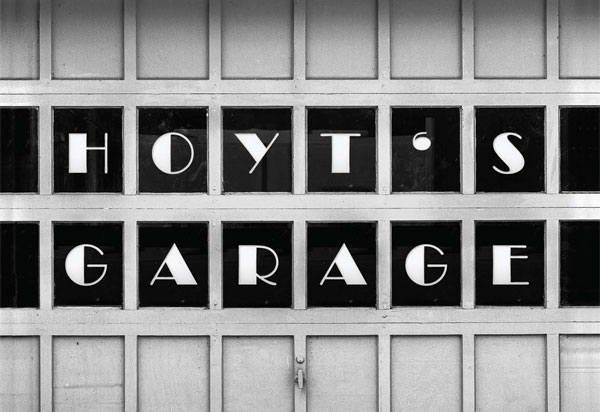
This album represents a long-overdue showcase of Hoyt Bohannon’s arrangements. Now gathering dust in the garage where they had been played for so many years, they deserve to be heard and played again.
I met Hoyt at Disneyland, playing in Harry James band. It was 1975, I was a traveling member of the band living in Los Angeles, and Hoyt was subbing with the band that night.
Hoyt asked me to play in his group the following week and I continued to do so until the group finally ceased to rehearse around 2003.
Hoyt’s group was a right of passage for trombone players in Los Angeles. It was an honor to be invited to play, and If you were invited back you knew you were an accepted member of the professional trombone community.
The challenge, the camaraderie and the musical education were vital to my development as a player and as a person and I know that I wouldn’t be the player I am today without the experience of playing at Hoyt’s.
In 2003, Jim Boltinghouse produced and spearheaded a wonderful recording of the Tommy Pederson concertos, recorded by a group of professional trombonists in Los Angeles. I had also hoped to make a studio recording of Hoyt's arrangements with the members of Hoyt's garage. Unfortunately, due to logistics, expense and attrition it became clear to me that to see this project done I would need to do it myself.
This group had a unique sound and style. Hoyt called it "Studio Legit". The players always used smaller bore tenor trombones and slide vibrato.
On this recording I used my Kanstul 1602BP tenor trombone with the Kanstul Kaplan mouthpiece throughout. On occasion, however, I played a Conn 88h with a Warburton 5Gs for some of the inner and lower parts (to give it more realistic resonance). I played the bass trombone parts on a Conn 62h with a Kanstul GRBH mouthpiece. Everything was recorded on an RCA 44B microphone with a PreSonus preamp onto Protools 8.
The following article is reprinted from the International Trombone Journal Volume 24 No. 2 Spring 1996.
Hoyt Bohannon's garage has never actually housed any musical rehearsals. On the other hand, theroom adjoining the garage at the Bohannon residence in North Hollywood, California, has served in thiscapacity ever since 1951, when Hoyt and his wife, Betty located this “garage” (Which incidentally came along with a beautiful home) for sale. Over the years, the L.A. area trombonists who have elevated theGarage’sweekly gatherings into a local institution have become synonymous with the room, hence their name,“Hoyt's Garage.”
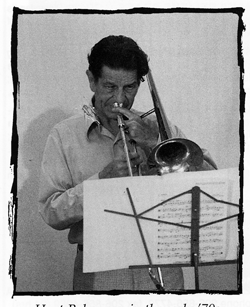
Hoyt Bohannon was a fabulous trombonist perhaps best known for his years with Harry James in the early 1940s, his dozen or so years as the first trombonist on staff at Warner Brothers after World War II, and his “40+” years as one of L.A.’s finest orchestral trombonists. Hoyt started this group in 1946
along with tubist Bart Hunt, bass trombonist Russ Brown, and a few other local studio trombonists. The idea of the group was basically to provide an opportunity for them to stay “in shape” and, at the same time, for them to get to play familiar string, woodwind, and vocal melodies through their adaptations and arrangements. At first, the weekly gatherings took place at Bart Hunt's house and also at Universal Studios and at other players' homes, including Hoyt and Betty's first house. Lloyd Ulyate, who joined the group in 1947, recalls that one of the players, John Stanley arranged “after hours" rehearsals on one of the sound stages at Universal; then, after the rehearsal, several of the guys used to race their cars on Ventura Boulevard tounwind.Lloyd also recalls that one of the weekly hosts, Bill Palmer, had several Siamese cats and it was too difficult to continue to rehearse at his house amidst the constant sneezing.Thank-fully once Hoyt and Betty moved to the”Garage” house on Vantage Avenue in 1951, the group finally had a safe and permanent base of operation.
During the first decade, Hoyt contributed to the majority of the Garage’s library growth, adapting church hymns, whole symphony movements,choral works and perhaps most importantly film cues. In his 12 years at Warner Brothers, Hoyt worked for many famous studio composers, such as Max Steiner, Ray Heindorf, and Dimitri Tiomkin, most of whomwere kind enough to lend Hoyt the scores for the cues that Hoyt felt would work well. He adapted approximately 30 of these for the group over the years. As evidence of Hoyt’s excellent "ear", he also flawlessly transcribed several Hi-Los and Singers Unlimited cuts direct-ly from the records. Evidence of this can be heard on the Singers Unlimited selection, It Came Upon a Midnight Clear on the Hollywood Trombones CD, Have Yourself a Merry Little Christmas. Lloyd remembers the symphonic adaptations to be the most difficult. According to Lloyd, “The symphony
adaptations were the most difficult toplay as there was practically no consideration for (the performers’) range, tempo, or endurance. Hoyt’s concept was to try to expand the ability ofevery player by playing very difficult adaptations of symphonic material. He felt that if you could even half-way play these pieces, going to work in the studios would be much easier.
In the mid 1950s, well-known trombonist and former band leader, Tommy Pederson, joined forces with Hoyt and helped contribute a number of original Works for trombone. Tommy composed over 250 pieces together with instructional etudes fortenor and bass trombone. In fact, he and Dick Noel used members of the Garage to record the well-known album, ”All My Friends are Trombone Players” which was produced by Dick and which featured Tommy’s writing. Between Hoyt, Tommy, and several other contributors, the Garage now has over 500 works for trombone for group sizes ranging from two to 16 plus rhythm (although 99% of the pieces are sans accompaniment).
The complete roster of the group from the past 50 years cannot, unfortunately, be reconstructed with certainty but would, nonetheless, include some of these tenured members (apologies to the many, many players who may have been improperly omitted)
Miles Anderson, Bill Atkinson, ]ohn Baimbridge, Les Benedict, HarryBetts, RogerBissell, Hoyt Bohannon, ]imBoltinghouse, Bill Booth, Bill Broughton, Russ Brown, Ernie Carlson, Pete Carpenter,
Ray Conniff, Dave Conway, Marshall Cram, Rick Culver, RossDeRoche, Harold Diner, Gil Falco, George Faye, Norm Fleming, Harold Garrett, ]ohn Grab, Tommy Greco, JohnHaliburton, Conrad Henning, Robbie Hioki, Steve Holtman, Joe Howard, Bart Hunt, Alex Iles, Alan Johnson, Alan Kaplan,Eddie Kusby, John Leys, Barney Liddell, Charlie Loper, AlMaebe, Roy Main, Andy Malloy, Loren Marsteller, BobMcChesney, Lew McCreary, Murray McEachern, Mike Millar,Charlie Morillas, Dick Nash, Dick Noel, Bruce Otto, Barrett O’Hara, Tom Padveen, Bill Palmer, Bob Payne, Tommy Pederson, Byron Peebles, Morris Repass, Jeff Reynolds, George Roberts, Robby Robinson, Jerry Rosa, Dave Ryan, Bob Sanders, Ken Sawhill, Jim Sawyer, Dan Seager, TommyShepard, Ken Shroyer, Charlie Small, Ron Smith, John Stanley,Don Staples, Vic Steelhammer, Mike Suter, Renee Suter, Ernie Tack, Paul Tanner, Phil Teele, Bill Tole, Gary Tole, Steve Trapani, Lloyd Ulyate, Don Waldrop, John Ward, Craig Ware,Gary Wasserman, Chauncey Welsch, Terry Woodson, and SiZelden
Also, many visiting out-of-town trombonists have been "put through their paces” at the Garage, humility being an invaluable virtue indeed. lt’s all in the spirit of good fun though, and
no one is left to ponder any “clams” on a piece for long before the next challenge is handed out by the conductor.
 A typical weekly Tuesday rehearsal (Which theoretically starts at 8:00 P.M.) goes as follows: any “first timers” usually arrive five to ten minutes before 8:00 at the front door to the main house where they are greeted by Betty (affectionately ”Betty Bo”) who directs them to the kitchen where all official break taking and coffee drinking occur. The”regulars” enter the kitchen via the back door at about 8:00 for a “pre-rehearsalbreak” and then shuffle on out to the garage in time for Bruce Otto's warm-up rendition of Tommy Pederson’s solo on Steve Allen’s Impossible and in time for the official start of the rehearsal at exactly 8:18.47 P.M. Depending on the group size, there may or may not be a conducting spot. If there is a conductor, they usually select a piece with hard first tenor trombone part (in order to terrorize the “first player”) and aneasy low tenor part (since the low tenor player will rotate to conductor on thefollowing piece and the “old” conductor will rotate to first). By the time of the official mid-rehearsal break, every player has completed at least one full clockwise rotation through each part in descending order. However, it should be noted that Hoyt and Tommy wrote all of the parts to be equally difficult; therefore, the downward rotation doesn’t necessarily provide any rest for the “weary.” The official break can start at any time but always ends promptly, for some reason, at 9:45 P.M. and the "redemption" half of the rehearsal ends mercifully at 10:30 P.M. with few exceptions.
A typical weekly Tuesday rehearsal (Which theoretically starts at 8:00 P.M.) goes as follows: any “first timers” usually arrive five to ten minutes before 8:00 at the front door to the main house where they are greeted by Betty (affectionately ”Betty Bo”) who directs them to the kitchen where all official break taking and coffee drinking occur. The”regulars” enter the kitchen via the back door at about 8:00 for a “pre-rehearsalbreak” and then shuffle on out to the garage in time for Bruce Otto's warm-up rendition of Tommy Pederson’s solo on Steve Allen’s Impossible and in time for the official start of the rehearsal at exactly 8:18.47 P.M. Depending on the group size, there may or may not be a conducting spot. If there is a conductor, they usually select a piece with hard first tenor trombone part (in order to terrorize the “first player”) and aneasy low tenor part (since the low tenor player will rotate to conductor on thefollowing piece and the “old” conductor will rotate to first). By the time of the official mid-rehearsal break, every player has completed at least one full clockwise rotation through each part in descending order. However, it should be noted that Hoyt and Tommy wrote all of the parts to be equally difficult; therefore, the downward rotation doesn’t necessarily provide any rest for the “weary.” The official break can start at any time but always ends promptly, for some reason, at 9:45 P.M. and the "redemption" half of the rehearsal ends mercifully at 10:30 P.M. with few exceptions.
Hoyt’s Garage has performed live on rare occasions. Hoyt Bohannon, Lloyd Ulyate, ]oe Howard and Si Zelden performed a composition by Stravinski, In Memoriam Dylan Thomas (later released on Columbia) for four trombones and string quartet. The work was performed September 20, 1954, on a Los Angeles "Monday Evening Concert" series (formerly the "Evenings on the Roof") program conducted by Robert Craft. The Garage has also performed on local Los Angeles classical and jazz stations and at Emmanuel Lutheran Church of North Hollywood. Most recently on June 1, 1995, the Garage performed at the ITW in Las Vegas in a joint concert with Bay Bones. The audience couldn't have been friendlier, and we hope to get the opportunity to play for a great group such as this again in the future.
Hoyt Bohannon left us on December 17, l990, but his wife, Betty, has graciously allowed Hoyt's Garage to live on. All of us who knew Hoyt and had the chance to play with him con- siderourselves privileged and we miss his steadying influence while, at the same time, cherish his musical legacy, "The Garage".
Note: Many, many thanks go to Mike Millar, who handled all of the logistics onthis piece, particularly the pictures, and to Betty Bohannon, Lloyd Ulyate and Barrett O’Hara for their invaluable input on the earlier years of the group.
- String Quartet E Minor Movement 1 / Verdi | $14.99
- Fool on the Hill/McCartney/Lennon | $14.99
- Mother Goose: 5. The Fairy Garden/ Ravel | $14.99
- Deux Portraits/ Bartok | $14.99
- Symphony no. 2: Movement 3 Allegretto Grazioso/ Brahms | $14.99
- Cue from Without Each Other / Tiomkin | $14.99
- Requiem 5. Agnus Dei / Faure | $14.99
- Cue from The Adventures of Don Juan/ Steiner | $14.99
- S no. 4: Movement 3 Scherzo/ Tchaikovsky | $14.99
- Cue from Forever Amber/ Raksin | $14.99
- Vocalise/ Rachmaninoff | $14.99
- A Touch of Drastic/ Pederson | $14.99
- Shenandoah/ Traditional | $14.99
- The Fountainhead | $14.99
- Pete Kelly's Blues | $14.99
